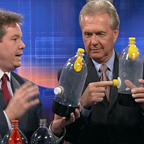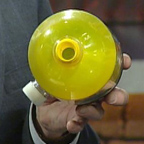
- Slip the balloon inside the neck of the bottle and stretch the mouth of the balloon over the bottle top.
- Take a deep breath and try to blow up the balloon inside the bottle. Good luck!
- Remove the balloon, fill the soda bottle to the brim with water, then seal it with a cap.
- Ask an adult to punch a small hole with a nail and hammer in the side of the bottle, close to the base.
- Remove the nail, uncap the bottle, and empty the water out the top.
- Place the balloon in the bottle again (Step 1) and try to blow up the balloon. Quite a difference! Blow hard until the balloon fills most of the bottle (a little water left in the bottle helps). Place a finger (or thumb) over the nail hole when you stop blowing. You are too cool! Now, move your finger.
How does it work?

The balloon won't inflate much the first time because the bottle is already filled with air. There's no room for the balloon to expand inside the bottle. However, when you punch a hole in the bottle, the air molecules in the bottle have an exit. They're pushed out as the balloon fills the space inside. As long as you plug the hole, the balloon stays inflated.
When you take your thumb off the hole, outside air flows back into the bottle as the balloon collapses.
Because of the elasticity of the rubber or latex, the balloon shrinks to its original size as the air rushes out the top of the bottle.
By the way, when you filled the bottle with water, you made its walls more rigid and it was easier to push the nail through the flexible plastic. Who'd ever think that flowing, soft water could give that much support?

Try this! Inflate the balloon in the bottle again and cover the nail hole with your thumb. Pour water into the balloon while keeping your thumb over the hole. Go outside or hold the bottle over a sink before you remove your thumb. Watch out for that stream of water gushing out of the bottle top! You might decide to hand a full water-balloon-bottle to a friend and just "forget" to tell them about the hole.
Suppose your thumb gets tired while the balloon is inflated. Put a cap tightly on the bottle and remove your thumb. For the air to flow, both holes have to be open. How would more holes or even one large hole change the speed of inflating and deflating the balloon? What would more or bigger holes do to the stream flowing from the water-balloon-bottle? Try it out! Balloons and bottles make a great science combo!
Source: http://www.stevespanglerscience.com/experiment/00000166
 Some things look so easy until you try them. Case in point, how hard would it be to inflate a balloon in a plastic soda bottle? Hey, no big deal. Just put the balloon down inside the bottle and puff away.
Some things look so easy until you try them. Case in point, how hard would it be to inflate a balloon in a plastic soda bottle? Hey, no big deal. Just put the balloon down inside the bottle and puff away. 
 The balloon won't inflate much the first time because the bottle is already filled with air. There's no room for the balloon to expand inside the bottle. However, when you punch a hole in the bottle, the air molecules in the bottle have an exit. They're pushed out as the balloon fills the space inside. As long as you plug the hole, the balloon stays inflated.
The balloon won't inflate much the first time because the bottle is already filled with air. There's no room for the balloon to expand inside the bottle. However, when you punch a hole in the bottle, the air molecules in the bottle have an exit. They're pushed out as the balloon fills the space inside. As long as you plug the hole, the balloon stays inflated. Try this! Inflate the balloon in the bottle again and cover the nail hole with your thumb. Pour water into the balloon while keeping your thumb over the hole. Go outside or hold the bottle over a sink before you remove your thumb. Watch out for that stream of water gushing out of the bottle top! You might decide to hand a full water-balloon-bottle to a friend and just "forget" to tell them about the hole.
Try this! Inflate the balloon in the bottle again and cover the nail hole with your thumb. Pour water into the balloon while keeping your thumb over the hole. Go outside or hold the bottle over a sink before you remove your thumb. Watch out for that stream of water gushing out of the bottle top! You might decide to hand a full water-balloon-bottle to a friend and just "forget" to tell them about the hole.



